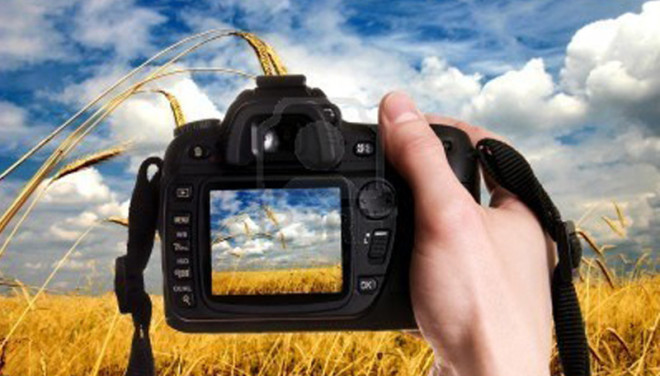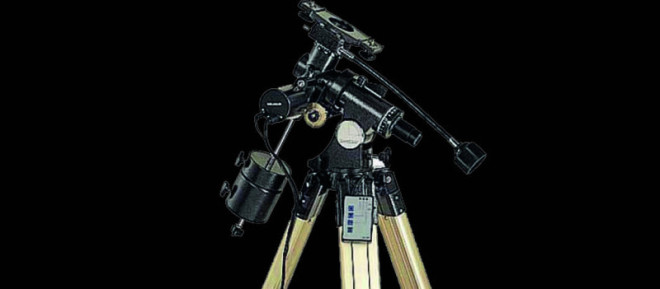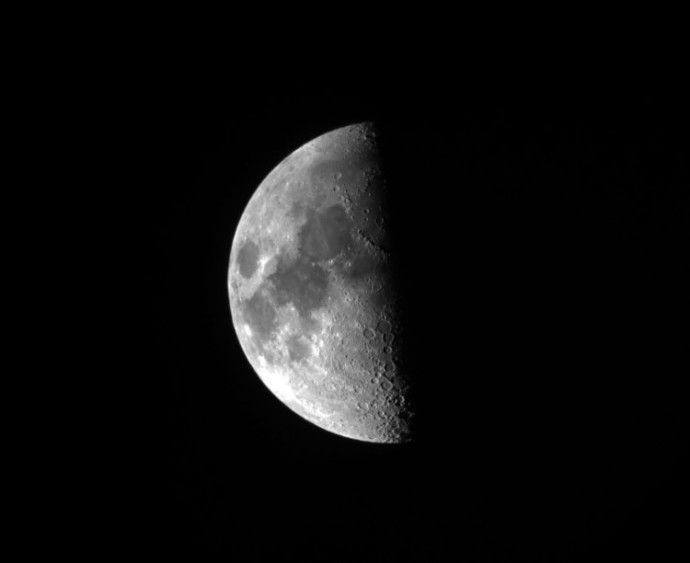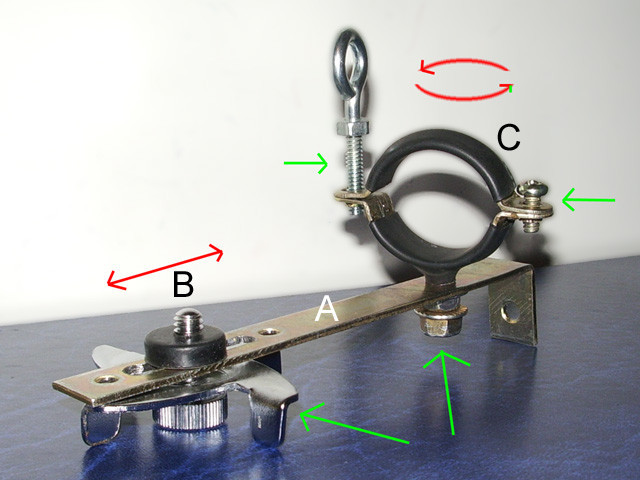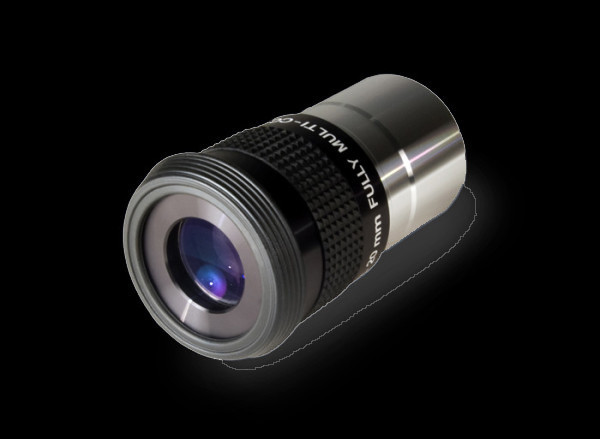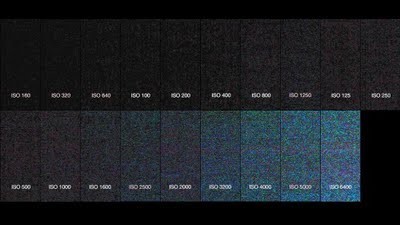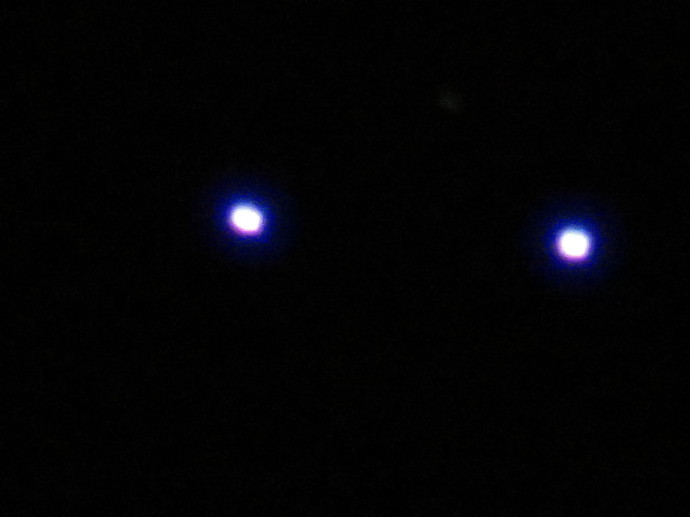IL METODO AFOCALE
Anno 2013
In un certo senso, quello afocale è il modo più “intuitivo” di fotografare attraverso un telescopio. In fin dei conti siamo abituati a fotografare quello che vediamo con gli occhi, sostituendo a questi ultimi una macchina fotografica. Lo facciamo ogni volta che scattiamo una fotografia a un paesaggio, a una persona, e a molti, anche non astrofili, è capitato di farlo cercando di immortalare la Luna di notte sul mare o vicino al profilo delle montagne.
In a sense, the afocal is the most "intuitive" to photograph through a telescope. After all we are used to photograph what we see with our eyes, replacing the latter a camera. We do this every time you take a photograph of a landscape, a person, and to many, even non-astronomers, happened to do so trying to capture the moon at night over the sea or close to the profile of the mountains.
Ecco, si fotografa così, no?
Risulta quindi logico, dopo aver guardato in un telescopio, avere la tentazione di fotografare quello che compare sul piccolo schermo dell’oculare. E’ una immagine fatta e finita, “facile” in un certo senso, e l’istinto di provare a riprenderla è innato.
Il bello del metodo afocale è, a mio modo di vedere, la sua semplice linearità. Anche chi non è esperto può, con un poco di manualità e mano ferma, riuscire a riprendere qualcosa. Vediamo quindi come fare affinché questo “qualcosa” si trasformi in una immagine presentabile.
It is therefore logical, after looking through a telescope, be tempted to take pictures of what appears on the small screen of the eyepiece. It 'a picture made and finished, "easy" in a sense, and the instinct to try to resume it is innate.
The beauty of the afocal method is, in my view, its simple linearity. Even those who are not expert can, with a little manual dexterity and steady hands, being able to shoot something. Let's see how to do this so that "something" is transformed into a presentable image.
PER INIZIARE
Innanzitutto serve un telescopio (ma potrebbe essere anche un comune cannocchiale o un semplice binocolo) ma soprattutto serve una montatura che segua, almeno accettabilmente bene, il moto apparente della volta celeste.
First need a telescope (but could also be a common telescope or a simple pair of binoculars), but mostly serves a frame that follows, at least acceptably well, the apparent motion of the celestial vault.
Esempio di montatura equatoriale motorizzata molto economica. Foto non dell'autore.
Quando si ha una montatura motorizzata (è sufficiente il moto elettrico in ascensione retta) basta installarci sopra un sistema ottico in grado di ingrandire le immagini che punta. Potrebbe essere, come dicevo, anche un semplice cannocchiale o un binocolo se non fosse che collegare questi alla montatura rischia di essere più complicato che non avere un piccolo telescopio.
Non servono strumenti impegnativi per cominciare, i negozi di astronomia pullulano di piccoli strumenti completi (montatura + ottica) a costi irrisori (parliamo di poche, pochissime centinaia di euro, meno del costo di un I-phone). Quando si è in possesso di uno di questi piccoli telescopi si è già a buon punto.
When you have a motorized mount (simply the electric bike in right ascension) installarci just over an optical system capable of magnifying images that tip. Could it be, as I said, even a simple telescope or binoculars except that connect these to the frame is likely to be more complicated than having a small telescope.
No need for tools challenging to begin with, the shops are full of little tools of astronomy complete (frame + lens) at very low costs (we're talking very, very few hundreds of Euros, less than the cost of an I-phone). When you are in possession of one of these small telescopes is already well under way.
Un classico strumento completo per principianti (funzionale ai nostri fini ed estremamente economico). Foto non dell'autore.
Quasi tutti, oggi, abbiamo inoltre una piccola fotocamera digitale tascabile. Chi non ne possiede una può acquistarla con costi a partire dai 50/60 euro ma, in linea di principio, può ance evitare di farlo perché sicuramente possiede un telefonino con integrata fotocamera. La qualità dell’obiettivo è “quella che è” ma per iniziare può essere sufficiente.
Almost everyone, today, we also have a small pocket digital camera. Who does not have one can buy with costs starting from 50/60 Euros but, in principle, reeds can avoid doing so because it definitely has a mobile phone with integrated camera. The quality of the lens is "what is" but to start may be sufficient.
Tipica compatta digitale da pochi euro (utilissima ai nostri fini). Foto non dell'autore
Basta puntare il telescopio alla Luna e accostare la fotocamera (o il telefonino) all’oculare e provare a scattare qualche immagine per capire cosa avviene e farsi una prima esperienza. Senza andare lontano, le immagini della Luna riprese con questo metodo (mantenendo cioè la fotocamera “a mano”) sono disponibili anche in questo sito.
Just point the telescope at the moon and
pull the camera (or mobile phone) to the eyepiece and try to take some pictures to see what happens and get a first experience. Without going any further, the images of the Moon taken with this
method (ie, by keeping the camera "by hand") are also available at this site.
Immagine "standard" della Luna ripresa in afocale. Foto dell'autore
Ovviamente, se si vuole fare qualcosa di meglio è necessario avere un supporto meccanico che tenga ferma la macchina fotografica. Si hanno due strade a questo punto: comprarne uno presso qualche rivenditore di materiale astronomico (costi variabili dai 40 agli 80 euro circa) oppure costruirselo (e qui ci si può sbizzarrire, basta avere manualità e voglia di impiegarla). Personalmente ne ho visti alcuni fatti in legno e bulloni di una semplicità imbarazzante.
Of course, if you want to make something better you must have a mechanical support that keeps the camera steady. You have two roads at this point: buy one at any dealer of astronomical equipment (variable costs from 40 to 80 euro) or build it (and here you can indulge, just have dexterity and want to use it). Personally, I've seen some made of wood and bolts embarrassingly simple.
Esempio di autocostruzione di un supporto per digitale. Foto e realizzazione non dell'autore
COSA SCEGLIERE
Ammettiamo, però, di voler fare le cose per bene e immaginiamo di approntare la strumentazione ideale per questo tipo di applicazione. Con l’aggettivo “ideale” mi riferisco, ovviamente, non al “meglio in assoluto” (quindi non a un apocromatico da 30 cm. con sistema custom e fotocamera immaginaria a funzioni illimitate) ma a un compromesso logico e consigliabile che offra un giusto equilibrio tra costi e prestazioni ottenibili.
Considerando il complesso e macchinoso “treno ottico” da realizzare propenderei per un telescopio rifrattore e, con un occhio al portafogli, a un semplice fraunhofer acromatico da 10 cm. e 1 metro di focale (un Vixen 102/1000 o un TAL 100 per esempio, o strumenti analoghi).
We admit, however, to want to do things right and imagine the perfect tool to prepare for this type of application. With the adjective "ideal" I mean, of course, not the "best ever" (not an apochromatic 30 cm., And custom camera system with imaginary unlimited features) but a compromise logical and advisable that offers a fair balance between cost and performance achievable.
Considering the complex and cumbersome "optical train" to be inclined to achieve a refracting telescope, and with an eye to portfolios, a simple Fraunhofer achromatic 10 cm. and 1 meter focal length (a Vixen 102/1000 or a TAL 100 for example, or similar tools).
Esempio di rifrattore da 10 cm. molto economico. Foto non dell'autore
La seconda scelta riguarda la digitale di ripresa le cui caratteristiche sono, per certi aspetti, più importanti di quelle dell’ottica principale.
Innanzitutto deve essere una “compatta tascabile” per motivi di peso che, altrimenti, metterebbero in crisi qualsiasi tipologia di sostegno “standard”. Soprattutto, però, questa “macchinetta” dovrebbe essere dotata di settaggi che permettono la priorità di tempi (deve quindi avere la possibilità di impostare il tempo di posa desiderato). Questa opzione è molto più importante del numero di milioni di pixel disponibili (ricordiamoci che operiamo in astronomia e non in fotografia naturalistica). Trovata e acquistata la fotocamera dobbiamo rivolgere la nostra attenzione ad un altro accessorio indispensabile: il supporto.
Qui nascono i veri problemi perché, sul mercato, non esistono supporti realmente adeguati. Quelli disponibili (tanto carini) si rivelano nell’uso piuttosto “traballanti” e richiedono una certa perizia e dolcezza nell’essere usati affinché svolgano bene il loro importantissimo ruolo. Paradossalmente, questi supporti (fatti in parte di plastica e in parte di metallo) costano poco meno di una fotocamera digitale decente e sono, senza peli sulla lingua, delle “porcate assolute”.
Io mi sono adattato ad utilizzare quello venduto da Tecnosky (e da tanti altri, ovviamente), costo di euro 65,00, di cui dirmi poco soddisfatto è un eufemismo (anche se sembra essere il “migliore” che ho trovato in commercio….).
The second choice concerns the digital camera whose characteristics are , in some ways , more important than the main optics .
First, it must be a " compact pocket " for reasons of weight , which otherwise would put in any type of crisis support "standard". Above all, however , this " machine " should be equipped with settings that allow the shutter priority (must then have the ability to set the desired shutter speed ) . This option is much more important than the number of millions of pixels available (remember that we work in astronomy and in wildlife photography ) . Found and purchased the camera we must turn our attention to another essential accessory : the media.
Here come the real problems because , in the market, there are really adequate supports . Those available ( so cute) are revealed in the use rather " shaky " and require some skill and sweetness being used well in order to play their important role . Paradoxically, these supports ( made of plastic and metal part ) cost less than a decent digital camera and are , bluntly , the " absolute filth ."
I have adapted to use the one sold by Tecnosky ( and many others , of course) , the cost of € 65.00 , which you tell me a little pleased is an understatement (although it seems to be the "best" that I found on the market .... ).
Il supporto per reggere le macchine fotografiche digitali in questa immagine applicato a un canocchiale di tipo terrestre. Foto non dell'autore.
COME FARE
Questa è la parte più difficile da affrontare. In parte perché il metodo afocale è talmente legato alla manualità e sperimentazione che risulta difficile tracciare una guida univoca, in parte perché sicuramente non sono un grande fotografo e la mia esperienza è limitata.
Accettate queste premesse ci si può sbilanciare in alcune considerazioni di fondo.
Bisogna, per cominciare, tenere ben presente che il sistema telescopio + focheggiatore + supporto + macchina fotografica non è un corpo unico solidale e non è nemmeno un complesso meccanico progettato e costruito con un fine preciso e dichiarato. Siamo di fronte all’assemblaggio di pezzi diversi, con tolleranze differenti, che generano disallineamenti, flessioni, e vibrazioni tali da non permetterci di raggiungere risultati utili a lavori di fotometria o di misurazione fini. A confronto dei problemi meccanici che il nostro “accrocchio” palesa, quelli che affliggono i fotografi che utilizzano le camere CCD collegate direttamente al telescopio sono bazzecole.
This is the most difficult to deal with. In part because the afocal method is so tied to the manual and testing it is difficult to draw an unambiguous guide , in part because they are certainly not a great photographer and my experience is limited.
Do you accept these premises we can tip the balance in some fundamental considerations .
We must , to begin with, keep in mind that the system telescope focuser + + support + camera is not a single united body , nor is it a mechanical unit designed and built with a specific purpose and declared . We are facing the assembly of different parts , with different tolerances , which create misalignment , bending and vibrations which do not allow us to achieve useful results in the work of photometry or measurement purposes . A comparison of the mechanical problems that our " crock " reveals , the ones that plague photographers using CCD cameras connected directly to the telescope are trifles.
Però, se abbiamo pazienza e un po’ di fantasiosa manualità, possiamo limitare i problemi meccanici ed essere ricompensati con buone immagini.
Come primo consiglio suggerirei l’utilizzo di oculari con focale medio-lunga in modo da limitare il fattore di ingrandimento finale e rendere quindi marginali gli effetti dei disallineamenti (ineliminabili) e delle vibrazioni.
However, if you have patience and a bit 'of imaginative craftsmanship, we can limit the mechanical problems and be rewarded with good pictures.
As a first tip I would suggest the use of eyepieces with focal medium-long in order to limit the magnification factor and thus make the final marginal effects of misalignments (unavoidable) and vibration.
Un semplice oculare Plossl economico da 20 mm. che si recupera per 30/40 euro al massimo sul mercato del nuovo.
Per eliminare le ultime consiglio di usare la modalità di scatto con timer (quella normalmente definita “autoscatto”) che permette un intervallo di una decina di secondi tra la pressione del pulsante di scatto e l’effettiva apertura dell’otturatore (digitale nel caso delle compatte). Questo offre al nostro strumento il tempo di “smorzare” le vibrazioni indotte dall’azione manuale e all’autofocus di tararsi per benino.
Altro consiglio “start-up” è quello di provare, soggetto per soggetto, a riprendere con vari tipi di sensibilità ISO. Non è detto, solo perché si fotografa di notte, che la scelta migliore corrisponda alla massima sensibilità offerta dal sensore. Nel caso di molte stelle doppie potrebbe ad esempio risultare più utile diminuire la sensibilità e, di conseguenza, la dimensione dell’alone dell’immagine stellare sul file (cosa che permette di apprezzare meglio la separazione tra le componenti).
To delete the last I recommend using the shooting mode with timer (the one usually referred to as "self-timer"), which allows an interval of ten seconds between pressing the shutter button and the actual shutter opening (in the case of digital compact). This tool offers our time to "dampen" the vibrations induced by the action of manual and autofocus grow to a pretty well.
Another tip "start-up" is to try, subject by subject, to resume with various types of ISO sensitivity. Not necessarily, because shooting at night, that the best choice corresponds to the maximum sensitivity offered by the sensor. In the case of many double stars could for example be more useful to decrease sensitivity and, consequently, the size of the halo of the star image on the file (which allows to appreciate better the separation between the components).
Resa alle varie sensibilità ISO, da 100 a 6400 ISO. Foto non dell'autore
Questo accorgimento risulta particolarmente utile nel caso si utilizzino ottiche non apocromatiche. I sensori delle macchine digitali sono infatti molto sensibili alla parte blu dello spettro e tendono a esaltare l’alone azzurro dovuto al residuo di aberrazione cromatica tipico degli obiettivi più semplici.
This trick is especially useful if you
are using non-apochromatic optics. The sensors of digital cameras are indeed very sensitive to the blue part of the spectrum and tend to bring out the blue halo due to the residual chromatic
aberration typical of the goals easier.
Ecco la nostra "aberrazione cromatica residua". L'immagine ritrae la coppia Epsilon Lirae nelle sue componenti principali (a basso ingrandimento). Si nota l'allungamento delle due immagini stellari che lascia intuire la duplicità dei sistemi. L'immagine è però finalizzata a mostrare quanta cromatica residua ci sia anche usando un buon rifrattore come il TeleVue Genesis. Il residuo di cromatica è dovuto solo in piccola parte all'obiettivo principale ed è invece accentuato dall'oculare e dall'obiettivo della macchina fotografica (ovviamente molto economico trattandosi di una compatta da poco più di 100 euro).
Here is our "residual chromatic
aberration." The image portrays the couple Epsilon Lirae in its main components (low magnification). We note the elongation of the two stellar images which suggests the use of two separate systems.
The picture, however, is intended to show how much residual chromatic there is also using a good refractor like the TeleVue Genesis. The remainder of color is due only in small part to the main
objective and the eyepiece and the objective is instead accentuated the camera (of course it is a very economical compact little over 100 euro).
Ultimo consiglio, apparentemente banale, è quello di trascrivere i dati di ogni singolo scatto. Dopo una serata fotografica con qualche decina di scatti eseguiti potrebbe risultare impossibile risalire non solo ai dati di ripresa (e va beh..) ma anche al soggetto (vedi esempio stelle doppie), cosa decisamente più imbarazzante!
Last advice, seemingly trivial, is to
transcribe the data of every single shot. After a night camera with a few dozen shots taken may be impossible to trace not only the shooting data (and okay ..) but also to the subject (see eg double
stars), something far more embarrassing!
Non resta che provare, riprovare, e provare ancora…
Buon “afocale” a tutti!
You just have to try, try again, and try again ...
Good "afocal" at all!
SMARTPHONE ADDENDUM
Nell’anno 2015, a cominciare dall’agosto, sono stati pubblicati su questo sito una serie di articoli sulla fotografia afocale perpetrata attraverso l’uso di SMARTPHONE. Li si possono trovare alla sezione dedicata con richiamo diretto dalla home page FOTOGRAFIA CON IL CELLULARE o al link diretto:
http://www.dark-star.it/fotografia-con-il-cellulare/
Consiglio a tutti gli interessati in materia di leggerli essendo, de facto, il primo vero esaustivo compendio alla fotografia astronomica planetari con smartphone esistente.
